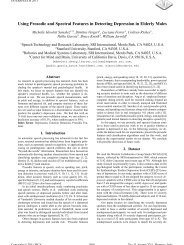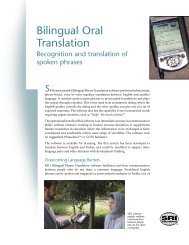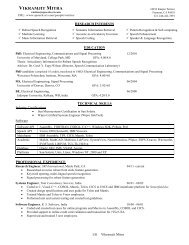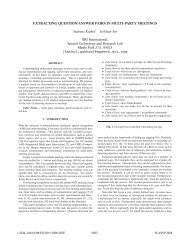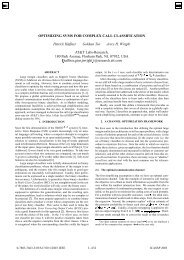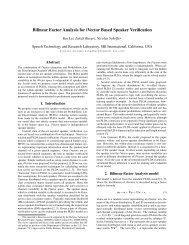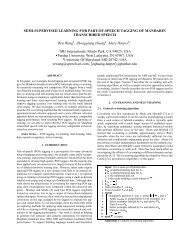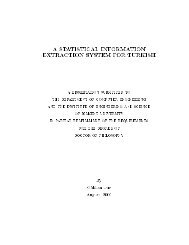eurasip2007-groupdel.. - SRI Speech Technology and Research ...
eurasip2007-groupdel.. - SRI Speech Technology and Research ...
eurasip2007-groupdel.. - SRI Speech Technology and Research ...
Create successful ePaper yourself
Turn your PDF publications into a flip-book with our unique Google optimized e-Paper software.
2 EURASIP Journal on Audio, <strong>Speech</strong>, <strong>and</strong> Music Processing<br />
a discussion on the significance of joint features in speech<br />
processing.<br />
2. SIGNIFICANCE OF FEATURE COMBINATIONS<br />
The technique of combination is widely used in statistics.<br />
The simplest method of combination involves averaging the<br />
various estimates of the underlying information. This idea is<br />
based on the hypothesis that if different estimates are subject<br />
to different sources of noise, then combining them will<br />
cancel some of the errors when an averaging is done. Good<br />
examples of combining features are the works of Christensen<br />
[22] <strong>and</strong> Janin et al. [25] who have combined different features<br />
before <strong>and</strong> after the acoustic model. Other significant<br />
works on feature <strong>and</strong> likelihood combination can be found<br />
in [33–36]. A combination system works on the principle<br />
that if some characteristics of the speech signal that is deemphasized<br />
by a particular feature are emphasized by another<br />
feature, then the combined feature stream captures<br />
complementary information present in individual features.<br />
2.1. Feature combination before the acoustic model<br />
The combination of features before the acoustic model has<br />
been used by Christensen [22], Okawa et al. [20], <strong>and</strong> Ellis<br />
[21], where efforts have been made to capitalize on the differences<br />
between various feature streams using all of them at<br />
once. The joint feature stream is derived in such an approach<br />
by concatenating all the individual feature streams into a single<br />
feature stream.<br />
2.2. Likelihood combination after the acoustic model<br />
This approach uses the technique of combining the outputs<br />
of the acoustic models. Complex techniques of combining<br />
the posteriors [22–26, 33–36] haveevolved.Inthiscontext,<br />
it is also worthwhile to note that if the intent is to capitalize<br />
on the complementary information in different features, the<br />
posteriors of the same classifier for individual features can<br />
be combined to achieve improved speech recognition performance.<br />
3. THE GROUP DELAY FUNCTION<br />
AND ITS PROPERTIES<br />
The resonances of the speech signal present themselves as the<br />
peaks of the envelope of the short-time magnitude spectrum.<br />
These resonances, often called formants, appear as transitions<br />
in the short-time phase spectrum. The problem with<br />
identifying these transitions is the masking of these transitions<br />
due to the wrapping around of the phase spectrum at<br />
multiples of 2π. The group delay function, defined as the<br />
negative derivative of phase, can be computed directly from<br />
the speech signal <strong>and</strong> has been used to extract source <strong>and</strong> system<br />
parameters [37] when the signal under consideration is a<br />
minimum phase signal. This is primarily because the magnitude<br />
spectrum of a minimum phase signal [37] <strong>and</strong> its group<br />
delay function resemble each other.<br />
3.1. The group delay function<br />
Group delay is defined as the negative derivative of the Fourier<br />
transform phase<br />
τ(ω) =<br />
d ( θ(ω) )<br />
dω , (1)<br />
where the phase spectrum (θ(ω)) of a signal is defined as a<br />
continuous function of ω. The Fourier transform phase <strong>and</strong><br />
the Fourier transform magnitude are related as in [38]. The<br />
group delay function can also be computed from the signal<br />
as in [14] using<br />
τ x (ω) = Im d( log ( X(ω) ))<br />
dω<br />
(2)<br />
= X R(ω)Y R (ω)+Y I (ω)X I (ω)<br />
∣ X(ω) ∣ ∣ 2 , (3)<br />
where the subscripts R <strong>and</strong> I denote the real <strong>and</strong> imaginary<br />
parts of the Fourier transform. X(ω) <strong>and</strong>Y(ω) are<br />
the Fourier transforms of x(n) <strong>and</strong>nx(n), respectively. The<br />
group delay function τ(ω) can also be viewed as the Fourier<br />
transform of the weighted cepstrum [37].<br />
3.2. Relationship between spectral magnitude<br />
<strong>and</strong> phase<br />
The relation between spectral magnitude <strong>and</strong> phase has been<br />
discussed extensively in [38]. In [38], it has been shown that<br />
the unwrapped phase function for a minimum phase signal<br />
is given by<br />
θ(ω) = θ v (ω)+2πλ(ω) =<br />
½∑<br />
c(n)sin(nω), (4)<br />
n=1<br />
where c(n) are the cepstral coefficients. Differentiating (4)<br />
with respect to ω,wehave<br />
τ(ω) =<br />
½∑<br />
θ ¼ (ω) = nc(n)cos(nω), (5)<br />
n=1<br />
where τ(ω) is the group delay function. The log-magnitude<br />
spectrum for a minimum phase signal v(n)[38]isgivenby<br />
ln ∣∣ V(ω) ∣ ½ c(0) =<br />
2 + ∑<br />
c(n)cos(nω). (6)<br />
The relation between spectral magnitude <strong>and</strong> phase for a<br />
minimum phase signal [38], through cepstral coefficients, is<br />
given by (4) <strong>and</strong>(6). For a maximum phase signal equation<br />
n=1



